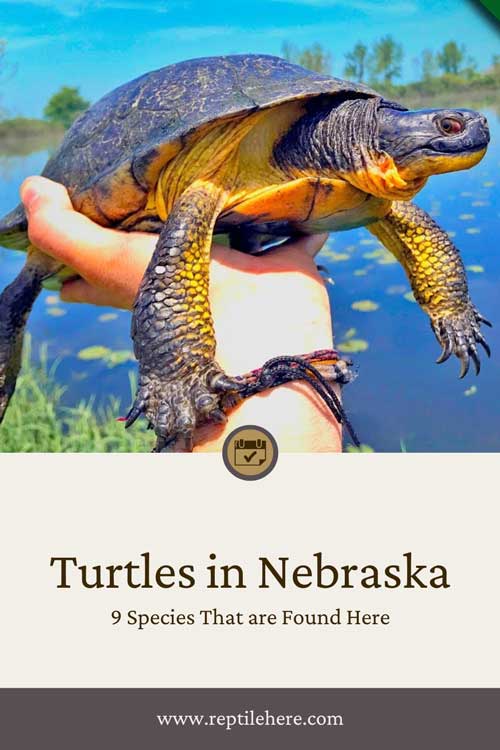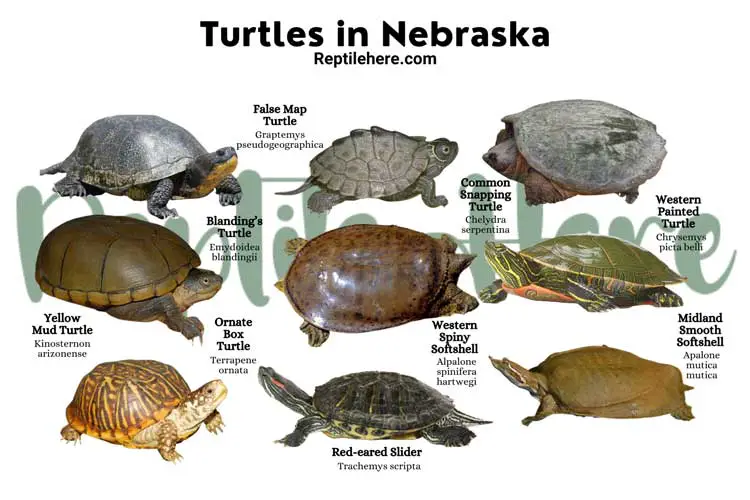Turtles in Nebraska – 9 Species That are Found Here
Nebraska is home to 9 turtle species ranging from snapping turtles to map turtles, smooth softshells, painted turtles, mud turtles, red-eared sliders, Blanding’s turtles, and the box turtles.
The state boasts open prairies, grasslands, and major river systems—all of which make it an ideal habitat for these various turtle species.
While some of these turtles like the common snapping turtle and ornate box turtles are widespread across the region, others like false map turtle and red-eared sliders are only found in select areas in the state.
Below is the complete list of the 9 species of turtles in Nebraska. For each species, we’ll look at basics such as physical appearance, average adult size, what they eat, where they live, lifespan, and conservation status.
9 Types Of Turtles In Nebraska
Contents
1. Common Snapping Turtle

- Scientific name: Chelydra serpentina
- Common name: Snapping Turtle
- Family: Chelydridae
- Size: 8 to 18 1/2 inches
- Lifespan: 30 to 50 years or more
- Conservation status: Least Concern
Common snapping turtles are widespread throughout Nebraska. An average adult is pretty large and has a shell length of 18½ inches long.
This species has a chunky head, a long tail, and large webbed feet. The shell color is black or olive and has no distinct pattern. These Nebraska snapping turtles are known for their powerful jaws—they’re so strong that these turtles eat other turtles!
You’ll find them in waterbodies with muddy bottoms. Examples include marshes, ponds, lakes, rivers, and even shallow streams. They generally prefer waters with aquatic vegetation in plenty and foods such as fish, frogs, birds, etc.
These Nebraska turtles generally show docile behavior but can get quite aggressive if taken out of water. The best way to calm it is to take it back to the waters, where it feels safe.
2. Western Painted Turtle
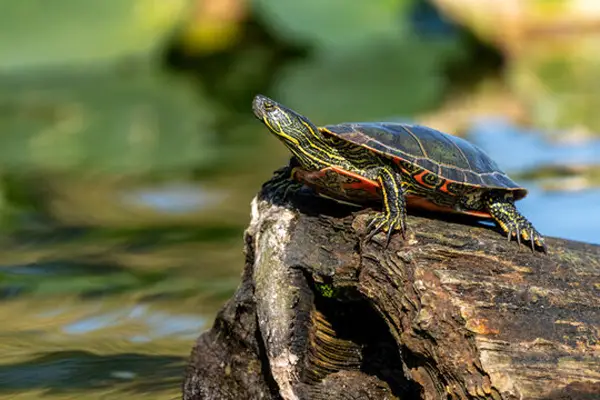
- Scientific name: Chrysemys picta belli
- Common name: Westland Painted Turtle
- Family: Emydidae
- Size: 4 to 10 inches
- Lifespan: 30 to 40 years
- Conservation status: Least Concern
The Western painted turtle is a subspecies of painted turtle and is also found in Nebraska waterbodies.
This turtle is identified by an oval-shaped carapace that lacks a ridge in the middle. The carapace is usually dark olive or black in color.
The lower side of the shell is usually red, with multiple dark markings in the center. And the skin itself is covered with yellow stripes.
Westland painted turtles of Nebraska are aquatic and their webbed feet help propel them in the waters.
The most common habitats for this turtle in Nebraska include slow-moving rivers, shallow streams, and lakes. They choose these areas because they can easily find food.
Given that they’re omnivorous, they feed on aquatic vegetation as well as meat from insects, snails, shrimps, tadpoles, and earthworms.
Their hatchlings are more carnivorous to help take in more proteins for building muscle.
3. False Map Turtle
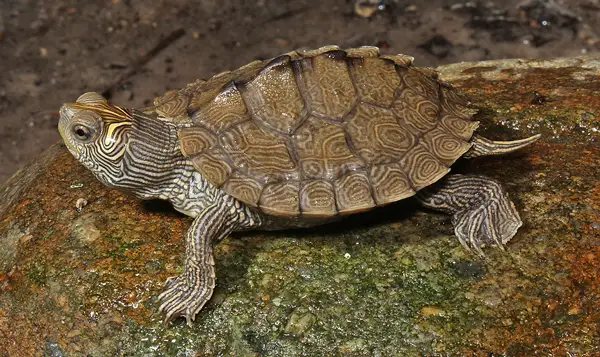
- Scientific name: Graptemys pseudogeographica
- Common name: False Map Turtle, Sawback Turtle
- Family: Emydidae
- Size: 6 to 10 inches (females), 3.5 to 6 inches (males)
- Lifespan: 30 to 50 years
- Conservation status: Least Concern
The False map turtle is another turtle species found in Nebraska. This turtle’s preferred habitat in Nebraska includes rivers, streams, and oxbow lakes of the Nebraska and Mississippi river systems.
It is an excellent swimmer and prefers moderate currents and deep waters.
Its upper shell coloring ranges from olive to dark brown, with light-colored lines on its limbs. It also features a line behind its eye that forms a backward “L” shape. The map pattern on its carapace tends to fade as the turtle ages.
Since this map turtle of Nebraska is omnivorous, it feeds on aquatic insects and animals as well as vegetation. It is fond of river snails and crustaceans. Don’t forget it has strong jaws and can give a nasty bite!
Like most of the other aquatic turtles of Nebraska, this map turtle spends most of its waking hours sunning.
The false map turtle is quite shy and quietly and swiftly slides into the water at the slightest signs of disturbance. It likes spending most of its time in water and is most active in climate conditions of over 85 degrees Fahrenheit.
4. Midland Smooth Softshell
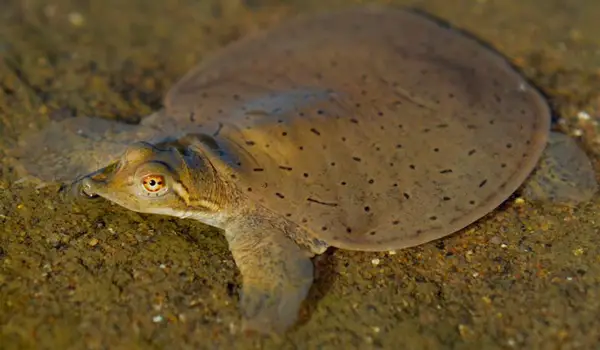
- Scientific name: Apalone mutica mutica
- Common name: Midland Smooth Shell
- Family: Trionychidae
- Size: 6 to 13 inches
- Lifespan: 40 to 60 years
- Conservation status: Least Concern
The smooth softshell turtle boasts its position as the fastest turtle on land in Nebraska!
Though most people believe these turtles are slow-moving, they must be quick to enable them to outrun their predators given that their soft shells don’t offer much protection.
Shell color of this turtle species ranges from olive to dark brown. The upper part of its shell features dark markings (with female markings appearing in a blotchier pattern than the males’)
The shell of these turtles also appears rounder and flatter, just like other softshell species.
These turtles like inhabiting waterbodies like rivers and streams in Nebraska that provide an abundance of mud or sand at the bottom. They can also be found in stagnant waterbodies.
Smooth softshell turtles of Nebraska are omnivorous and their diet revolves around aquatic vegetation and insects.
However, they have been observed to like meat more than plant matter and will mainly eat snails, insects, and fish.
Also read: Turtles in North Carolina
5. Western Spiny Softshell
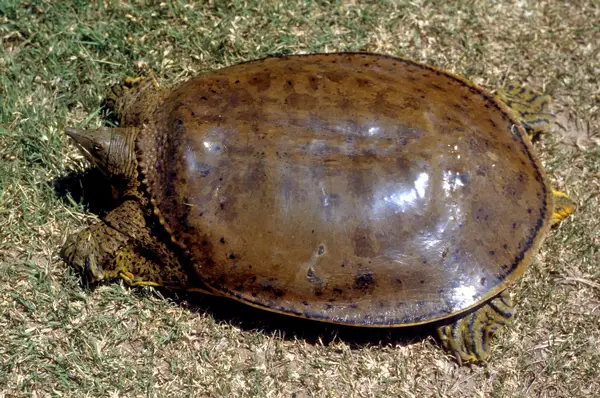
- Scientific name: Alpalone spinifera hartwegi
- Common name: Spiny Softshell Turtle
- Family: Trionychidae
- Size: 5 to 9 inches (males), 12 to 20 inches (females)
- Lifespan: 30 to 70 years
- Conservation status: Least Concern
The Western Spiny softshell turtle is a medium-to-large freshwater species that lives in Nebraska’s lakes, streams, and rivers with muddy or sandy bottoms and little or no vegetation.
Female spiny softshell turtles are usually larger than males. And unlike other turtles, this species has a flexible, leather-like carapace that’s extremely rounded and flattened. The shell color can be olive grey or yellow-brown. Just like other softshell turtles, this species also has a snorkel-like snout.
The young ones feature well-defined round spots that are easily visible on the shell (though these spots become invisible as they transition to adulthood).
Spiny softshell turtles in Nebraska tend to eat anything they find in the waters including crayfish, insects, small fish, and so on. They hunt by burying themselves in the mud or sand while keeping their head uncovered to grab food as it swims by.
These turtles are also able to breathe underwater by taking in oxygen through their throat skin. This is a useful adaptation given that they don’t spend a lot of time out of water.
Other adaptations of these turtles include webbed feed, long claws, and extremely flat shells that enable them to quickly swim away from predators and burry in the muddy bottom of the waters they reside in.
6. Blanding’s Turtle
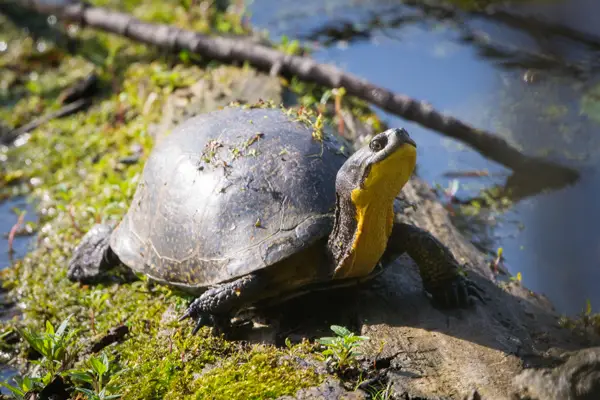
- Scientific name: Emydoidea blandingii
- Common name: Blanding’s Turtle
- Family: Emydidae
- Size: 5 to 8 inches
- Lifespan: up to 80 years (or more!)
- Conservation status: Endangered
Blanding’s Turtle is also known as the “turtle that smiles” and is named in honor of William Blanding, the American naturalist.
The species is semi-aquatic and is categorized under endured species in Nebraska. It is mainly concentrated in the northern half of this state, but its population is quite scattered—making it hard to find.
Blanding’s turtle has a dark oval shell covered with faint yellow speckles. The lower side of its shell is usually yellow with black patches.
Blanding’s turtle in Nebraska prefers living in marshy habitats. And the fact that it’s losing these favorite habitats is one of the reasons causing its population to decline fast.
Because this turtle species is omnivorous, it feeds on leatherworks, crayfish, and aquatic invertebrates. It also occasionally feeds on plants and doesn’t rely on water to help it sallow its food as it’s the case with most turtle species.
7. Red-eared Slider
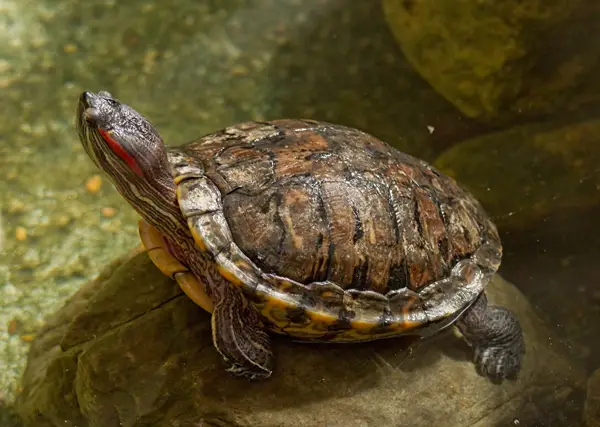
- Scientific name: Trachemys scripta
- Common name: Red-eared Slider, Red-eared Terrapin
- Family: Emydidae
- Size: 7 to 11 inches
- Lifespan: 30 to 40 years
- Conservation status: Least Concern
The red-eared slider is a subspecies of pond sliders and a native species of Nebraska. It is a semi-aquatic turtle and prefers living in marshes, ponds, lakes, and creeks.
A red-eared slider gets its name from the small red stripe surrounding its ears (or behind the eye), and its ability to quickly slide off logs and rocks into the water.
Generally, the skin and shell coloration of this slider can be brown or black, with yellow stripes covering the skin.
The red-eared sliders of Nebraska are pretty large and the adults reach 7-12 in length (though females are generally larger than males).
These Nebraska pond sliders are omnivorous and like eating fish, snails, insects, and aquatic vegetation. They also eat land vegetation, including fruits and vegetables.
8. Yellow Mud Turtle
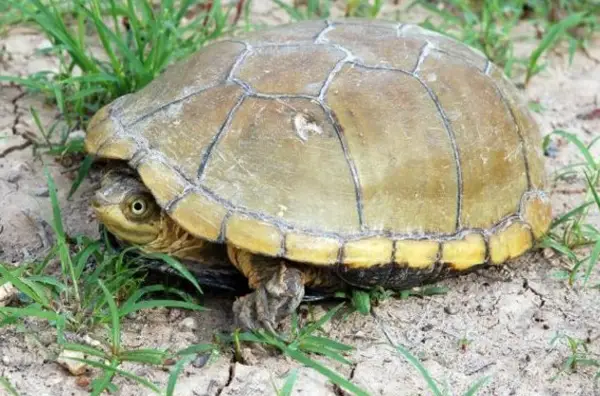
- Scientific name: Kinosternon arizonense
- Common name: Yellow Mud Turtle, Mud Turtle
- Family: Kinosternidae
- Size: 4-5 inches
- Lifespan: 40 years
- Conservation status: Least concern
The Yellow mud turtle is a species native to Nebraska and prefers living in any waterbody in Nebraska state.
Possible places you can find it includes muddy pools, cattle tanks, irrigation ditches, sewer drains, and even cisterns!
This turtle will spend more time on land migrating to new water sources and is never picky about where it can stay.
It has its upper shell part flattened with colors varying from brown to black or olive. It also features dark brown edges around its scutes. The skin color is usually olive. Males have a sharp or horny end as a distinctive feature.
This Nebraska yellow mud turtle is omnivorous like any other mud turtle. its diet is made up of a variety of foods including tadpoles, leeches, crayfish, fairy shrimp, and fish.
It will also eat frogs, slugs, and snails. And as an opportunistic feeder, it will also eat decaying animal and plant matter.
9. Ornate Box Turtle
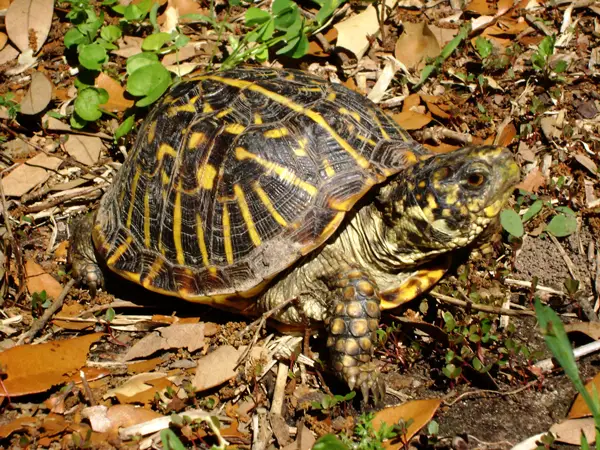
- Scientific name: Terrapene ornata
- Common name: Ornate Box Turtle
- Family: Emydidae
- Size: 5 to 7 inches
- Lifespan: 40 to 60 years
- Conservation status: Near Threatened
Ornate box turtles are present in Nebraska and are recognized by the beautiful pattern on their carapace. This eye-pleasing pattern is sometimes referred to as a starburst pattern.
Their skin is grey and may feature yellow or white spots. Male heads occasionally feature green color.
Though there exists a little distinction between the males and females of these Nebraska box turtles, males are generally smaller than females.
During hot weather, this turtle requires water to help regulate its body temperature.
The Nebraska species of turtle are known to hibernate in burrows during cold weather. They’re also capable of surviving in frozen soils for several days.
Being omnivorous in nature, and opportunistic feeders, these turtles will gladly feed anything available to them in their habitat or what’s abundant in a given season. They have been observed eating fruits, vegetables, grasshoppers, and various other insects.
Also, keep in mind that these box turtles in Nebraska are pretty shy and don’t like being handled excessively. As such, you may want to avoid approaching them suddenly while in the wild in Nebraska.
Related: Turtle in Connecticut
Conclusion
That’s it for the 9 turtle species found in Nebraska. Just a recap, the turtles found in this state include common snapping turtles, map turtles, smooth softshells, painted turtles, yellow mud turtles, red-eared sliders, Blanding’s turtles, and the ornate box turtles.
The varied list of species of turtles in Nebraska can be attributed to the grasslands, open prairies, and major rivers which provide suitable habitats for these turtle species.
Note that some of these species, e.g. the Blanding’s turtle, are endangered and illegal to own in Nebraska and are under protection by the law.
However, the most common species are 100% legal to own and you can keep them as pets.
